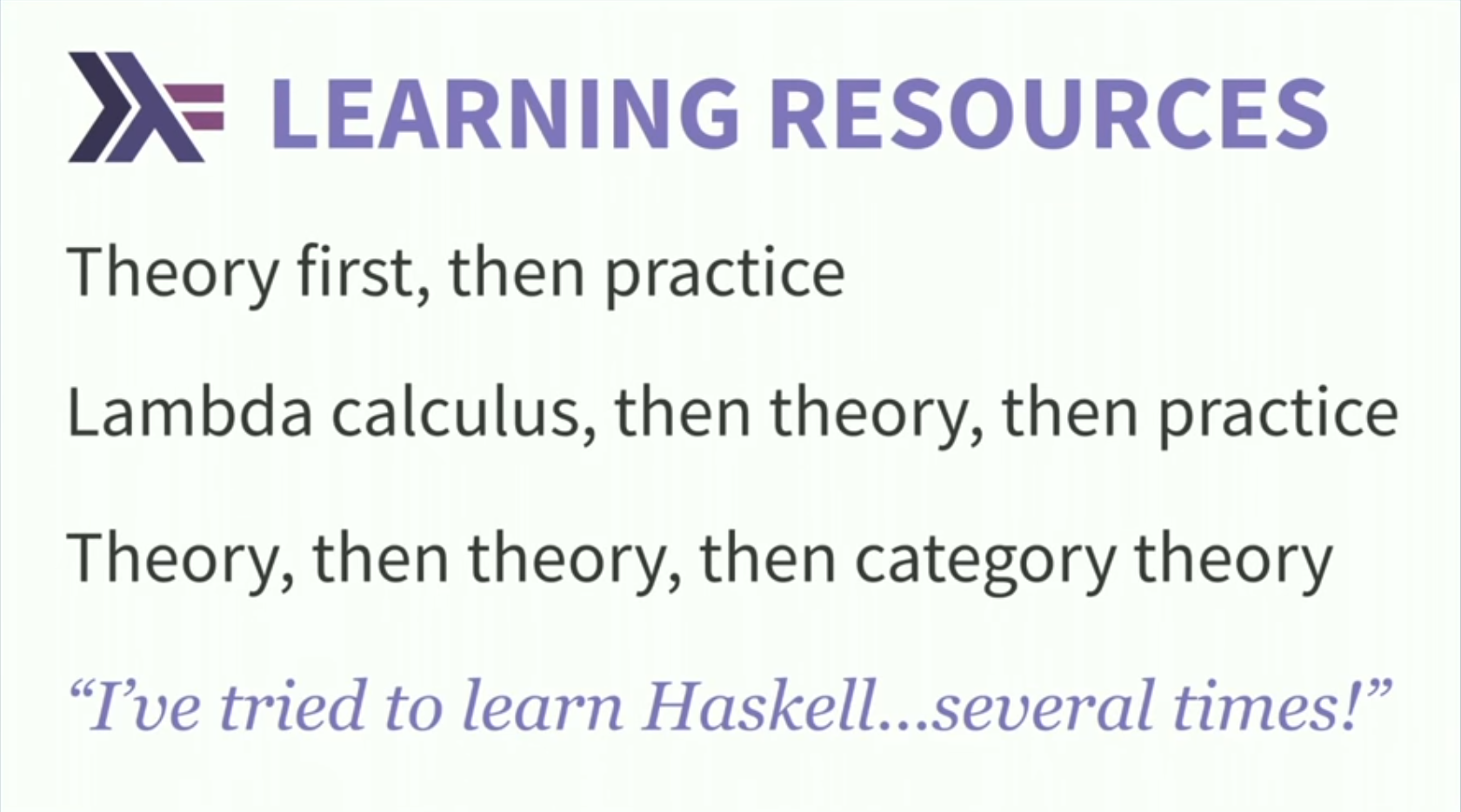In fact, we can even write foldl using foldr!
Understanding foldl in terms of foldr
If you want to set yourself a solid challenge, try to follow the above definition of foldl using foldr. Be warned: this is not trivial! You might want to have the following tools at hand: some headache pills and a glass of water, ghci (so that you can find out what the id function does), and a pencil and paper.
前几天群里有人发了篇文章:
5 Emerging Programming Languages With a Bright Future
这五门语言分别是:Elm, Kotlin, Rust, elixir, Crystal。
Elm,Hmm,不禁让我想起了两年前在小黑屋里的日子。这几年Elm有什么长足的进步吗?然后我竟然去YouTube上搜了下。然后看了下面的视频。
From Rails to Elm and Haskell - Richard Feldman
诚然,Elm的函数式编程的特性很吸引我。
上面的视频有一段关于
如何学习 haskell :

呵呵。
然而,
I've tried learn Haskell...several times!
于是重新打开了翻开了很多次的,《Real World Haskell》。
这次从第四章开始吧。
下面是关于第四章中,foldl,foldr的内容。
先来看看foldl的定义
1: import Prelude(id) 2: 3: foldl :: (a -> b -> a) -> a -> [b] -> a 4: foldl step zero (x:xs) = foldl step (step zero x) xs 5: foldl _ zero [] = zero
例如计算[Integer]的和:
1: import Prelude((+)) 2: 3: foldl (\a b -> a+b) 0 [1,2,3,4] 4: 5: foldl (+) 0 [1,2,3,4]
而foldr的定义是这样的
1: foldr :: (a -> b -> b) -> b -> [a] -> b 2: foldr step zero (x:xs) = step x (foldr step zero xs) 3: foldr _ zero [] = zero
同样用foldr也可以计算[Integer]的和:
1: import Prelude((+)) 2: 3: foldr (\a b -> a+b) 0 [1,2,3,4] 4: 5: foldr (+) 0 [1,2,3,4]
看似作用相同,但是foldl和foldr的计算步骤(顺序)是不一样的,foldl从左往右计算,而foldr则是从右往左。
比如把用foldl计算[Integer]的过程展开:
((((0) + 1) + 2) + 3) + 4
比如把用foldr计算[Integer]的过程展开:
(1 + (2 + (3 + (4 + (0)))))
重点来了,其实我们常用的 map :: (a -> b) -> [a] -> [b] 函数也可以用foldr来表达。
1: myMap f xs = foldr step [] xs 2: where 3: step x ys = f x : ys
filter :: (a -> Bool) -> [a] -> [a] 函数也可以用foldr来表达。
1: myFilter p xs = foldr step [] xs 2: where 3: step x ys 4: | p x = x : ys 5: | otherwise = ys
我们来说标题。事实上,foldl函数也能够用foldr来表达。
1: myFoldl :: (a -> b -> a) -> a -> [b] -> a 2: myFoldl f z xs = foldr step id xs z 3: where 4: step x g a = g (f a x)
然后《Real World Haskell》第四章的作者在写完上面这段代码之后,就写了本文开头引用的那段话。
foldr函数有三个参数,我们可以加上括号,来帮助思考
1: myFoldl :: (a -> b -> a) -> a -> [b] -> a 2: myFoldl f z xs = (foldr step id xs) z 3: where 4: step x g a = g (f a x)
整个函数的返回值是a,而z的类型也是a,那么括号中的表达式的类型为 a -> a,是一个从类型a到类型a的映射(入参类型为a,出参类型为a的函数)。而id这个函数,则是Prelude模块中的函数,也就是Identity function(恒等函数),恒等函数是数学中对于传回和其输入值相同的函数的称呼。也就是括号中foldr的初始值是identity function,其类型在此场景下为 a -> a。那么step函数的类型为:
step :: b -> (a -> a) -> (a -> a)
也可以写成
step :: b -> (a -> a) -> a -> a
那么上面代码中where后面step的参数声明中x、g、a的类型分别为:
1: x :: b 2: g :: a -> a 3: a :: a
同时 step x g 的类型为:
1: step x g :: a -> a 2: step x g = \a -> g (f a x)
当 xs = [] 时
(\a -> id a) z
当 xs = [x1] 时
(\a' -> ((\a -> id a) (f a' x1))) z
当 xs = [x2, x1] 时
(\a'' -> (\a' -> ((\a -> id a) (f a' x1))) (f a'' x2)) z
当 xs = [x3, x2, x1] 时
(\a''' -> (\a'' -> (\a' -> ((\a -> id a) (f a' x1))) (f a'' x2)) (f a''' x3)) z
以此类推。
大概就这样吧。